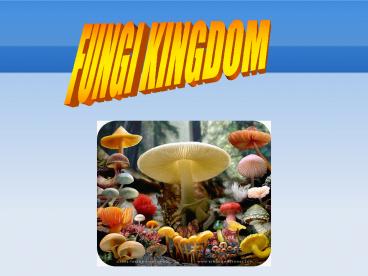FUNGI KINGDOM - PowerPoint PPT Presentation
Title:
FUNGI KINGDOM
Description:
Index -Characteristics of fungi kingdom -Characteristics of fungi kingdom 2 -Classification of fungi kingdom -Reproduction of fungi kingdom -Sexual reproduction ... – PowerPoint PPT presentation
Number of Views:220
Avg rating:3.0/5.0
Title: FUNGI KINGDOM
1
FUNGI KINGDOM
2
Index
- -Characteristics of fungi kingdom
- -Characteristics of fungi kingdom 2
- -Classification of fungi kingdom
- -Reproduction of fungi kingdom
- -Sexual reproduction
- -sexual reproduction 2
- -Asexual reproduction
- -Asexual reproduction 2
- -the three types of asexual reproductions
- -Spores
- -Spores 2
- -Major groups of fungi
- -Major groups of fungi 2
- -Parts of a mushroom
- -Mushrooms
- -Moulds
- -Yeasts
- -Lichens
- -The end
- -Bibliography
3
Characteristics of fungi kingdom
- Fungi are a diverse group of unicellular or
multicellular organisms that feed by direct
absorption of nutrients. The food is dissolved by
enzymes segregated by fungi, are absorbed through
the cellular wall and is distributed by simple
diffusion in the protoplasm. Along with bacteria,
fungi are the cause of putrefaction and decay of
all organic matter. - Fungi kingdom includes mushrooms, molds and
yeasts.
4
Characteristics of fungi Kingdom 2
- The fungi were contained in the previous
classification as a division of the plant kingdom
(Plantae). Scientists believed that fungi were
plants that have stems or leaves and that in the
course of its transformation into organisms
capable of absorbing their food, had lost their
chlorophyll, and therefore its capacity for
photosynthesis. But now scientists believe that
one is totally independent group, which evolved
from pigment-free flagellates. - The Fungi are eukaryotic organisms that produce
spores to reproduce, it haven't
got chlorophyll, which are nutrient absorption,
usually with sexual and asexual reproduction. - It can reproduce sexually and asexually.
- The spores are dispersed by air.
5
Classification of fungi kingdom
- .
6
Reproduction of fungi Kingdom
- All living things of the fungi kingdom
reproduces by spores. - There are two types of spores
- The asexual, in which the spores are usually
resistant to drought and radiation, but no heat,
so no latency period. Germinate when moisture is
present, even in the absence of nutrients. - The sexual, the spores are more resistant to heat
than asexual, though not as bacterial endospores,
usually have latency, germinating only when is
activated (eg by gentle heat or a chemical).
7
Sexual reproduction
- The sexual reproduction is used when
environmental conditions are poor. - In the sexual reproduction, the spore production
is preceded by meiosis of the cells, the spores
produced by meiosis are called meiosporas.
8
Sexual reproduction 2
- they aren't male or female fungi.
- To reproduction sexually the fungi forms a hyphae
with 2 nuclei that becomes a zygote. - The zygote divides to make a spore.
9
Asexual reproduction
- The ability to reproduce asexually is common to
almost all fungi. - The elements of asexual propagation (asexual
spores) may be generated internally, by rounding
cell inside the hyphae and being surrounded by a
thick wall and then discard. - They can also be generated externally, such as
production of hyphae rather than as a
transformation. - There are three types of asexual reproduction.
10
The three types of asexual reproduction
- Fragmentation - part of the mycelium becomes
separated and begins a life of its own. - Budding - a small cell forms gets pinched off
as it grows to full size. used by yeasts. - Asexually spores - production of spores by a
single mycelium
11
Spores
- Spores are an adaptation of life in land.
- The spore are a reproductive cell, generally it
can grow in a new organism without having to join
with an other cell - The spores are the reproductive system of the
fungi kingdom. - Fungi spores are very small, so they can not
store many substances.
12
Spores 2
- Spores are made of
- -Dehydrated cytoplasm.
- -Protective coat.
- -Haploid cell.
- Spores germinates when they land on a moist
surface (new hyphae form) - Wind, animals, water and insects spread spores.
13
Major groups of fungi
- CLSIFICATION BY NUTRTION
- Saprobes
- Decomposers
- Molds, mushrooms, etc
- Parasites
- Harm host
- Rusts and smuts (attack plants)
- Mutualists
- Both benefit
- Lichens
- Mycorrhizas
14
Major groups of fungi 2
- Basidiomycota Club Fungi
- Zygomycota Bread Molds
- Chytridiomycota Chytrids
- AM Fungi - Mycorrhizas
- Ascomycota Sac Fungi
- Lichens Symbiosis (algae Fungi)
15
Parts of a mushroom
16
Mushrooms
- Until recently it was believed that mushrooms are
vegetables and belonged to the kingdom of plants,
but recently but knowing that mushrooms haven't
got chlorophyll but yes chitin , a component that
have the animals like crustacean, it was create a
kingdom for that called Fungi kingdom.
17
Molds
- The moulds are microscopic species of fungi fungi
that grow as multicellular or unicellular
filaments. - They grow best in warm and wet conditions.
- They reproduce and spread by spores.
- The spores of the moulds can survive in various
environmental conditions.
18
Yeasts
- All single-celled microscopic fungus are yeasts.
- They are so important for their ability to
perform the decomposition by fermentation of
organic bodies. - yeasts reproduce asexually by budding or budding
and sexually by ascospores or basidiospores.
19
Lichens
- The lichens are a mutualism between
- -Fungus (structure)
- -Algae or cyanobacteria.
- LICHEN STRUCTURE
20
THE END
21
Bibliography
- http//www.monografias.com/trabajos42/reproduccion
/reproduccion.shtml - http//www.euroresidentes.com/Alimentos/hongos/set
as.htm - http//es.wikipedia.org/wiki/Espora
- http//es.wikipedia.org/wiki/Moho
- http//www.google.es/search?qpartsofamushroom
hlessaXrlz1T4GGLL_esES319ES360biw1003bih5
32prmdivnstbmischtbousourceuniveiavHjTZW
FGc-WhQfiyMnrBwved0CBwQsAQ































